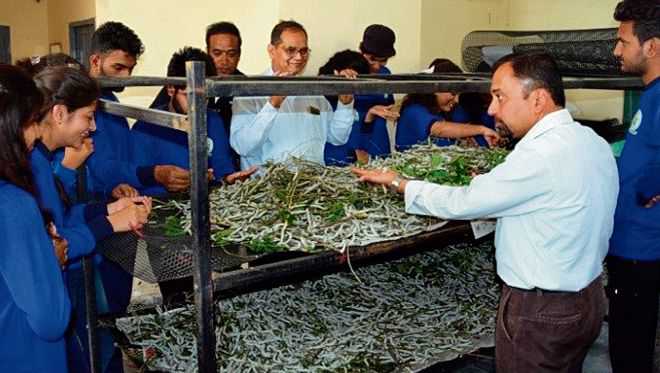Sericulture income-generating enterprise, shows promise
Ambika Sharma
To disseminate the technical knowhow of sericulture to the agrarian community of the state, the College of Horticulture and Forestry, Neri, Hamirpur, has taken up this course as one of its experiential learning programme for forestry students.
A sericulture lab-cum-silkworm rearing room is being set up in the college and students are being educated about the various aspects involved in sericulture including mulberry cultivation and silkworm rearing. Students produced cocoons amounting to Rs 2,500 in a course spanning four weeks.
Different clones of mulberry have been procured from Nadaun and they are being raised on the college campus itself. As many as 50 plants of S146 clone have been planted in 2017 in the experimental farm of the college at Khaggal and about 100 plants during this year in August around the college campus. Efforts are on to procure clones from silkworm rearing centre Bilaspur and rear them in the college. The clones will be tested for the preference of silkworm and the most-preferred clone will be selected on the basis of feeding by caterpillars.
“The raw silk production of 25 metric tonne secured from Hamirpur district during 2015-16 explains the potential of sericulture industry in the state. Nadaun and Kangoo centres of Nadaun block in Hamirpur district produced 2,950 kg and 1,710 kg of green cocoon in 2017 involving 300 and 250 farmers, respectively. This has become a source of potential livelihood in the area. In Neri and Amroh villages, adjoining the College of Horticulture and Forestry, Neri, Hamirpur, 35 farmers are engaged in silkworm rearing, which helps them supplement farm income,” said Dr Parvinder Kaushal, Vice-Chancellor, Dr YS Parmar University of Horticulture and Forestry, Nauni.
In Himachal Pradesh, the main focus is on the crop of March-April, though some farmers also take to second crop in the month of August. Sericulture can be practiced even with very low land holding. Generally 1 acre of mulberry garden and silkworm rearing can support a family of three without hiring labour explain scientists.
“It is a labour-intensive activity providing direct and indirect employment to many families. More than 60 lakh people are engaged in various sericulture activities in the country. Every 3.07 kg of silk produced and used in handlooms generates gainful employment of one man year. This potential is par-excellence and is better than many other industries. About 57 per cent of the gross value of silk fabrics flow back to the cocoon growers. Estimated investments of Rs 15,000 to 20,000 (excluding cost of land and rearing space) is sufficient for undertaking mulberry cultivation and silkworm rearing,” said Dr PC Sharma, Dean, Neri College.
The larvae of silkworms are to be fed on mulberry leaves. Mulberry takes only 3 to 4 years to grow for commencement of silkworm rearing. Once planted, it goes on supporting silkworm rearing year after year for 15-20 years. Two crops can be taken in one year under Himachal mid-hill conditions. Major concentration of sericulture is in the districts of Bilaspur, Kangra, Mandi, Hamirpur, Una and Sirmaur in Himachal Pradesh.
The avocation offers vast potential for the unemployed youth and sericulture-related activities are generating about 7 lakh man-days and provide gainful employment to about 9,000 families in the state.
Unlock Exclusive Insights with The Tribune Premium
Take your experience further with Premium access.
Thought-provoking Opinions, Expert Analysis, In-depth Insights and other Member Only Benefits
Already a Member? Sign In Now










